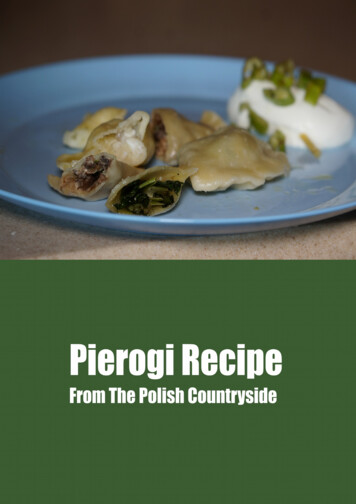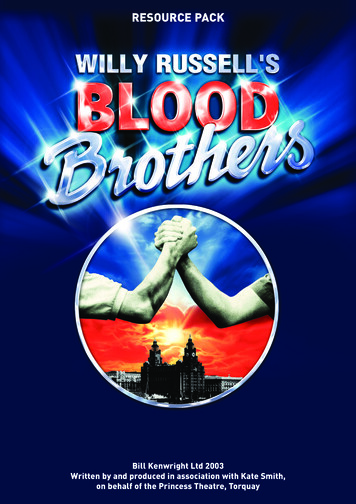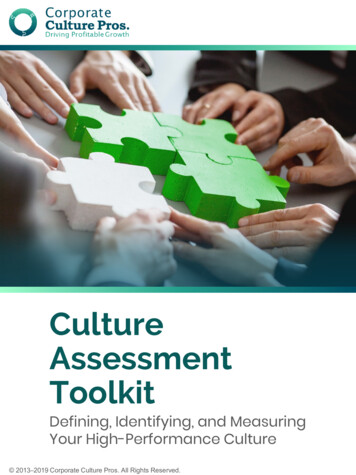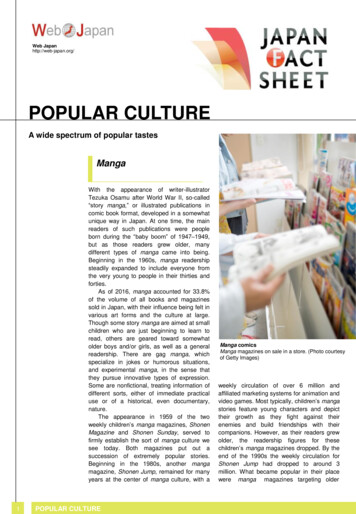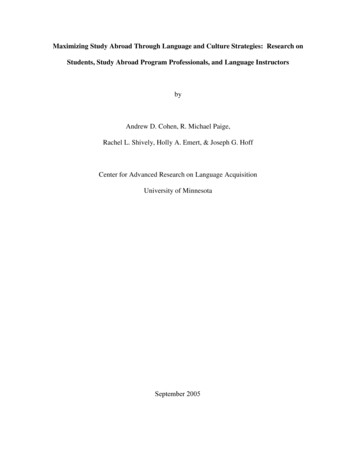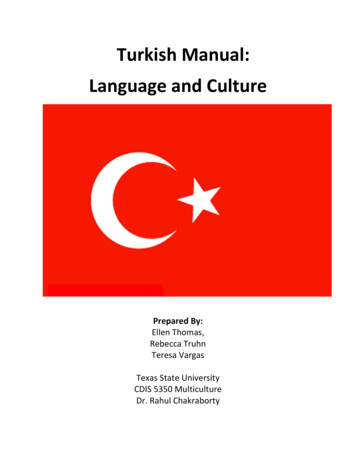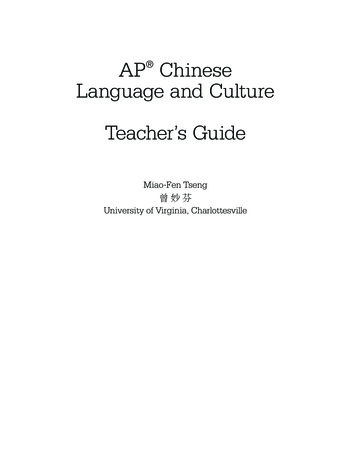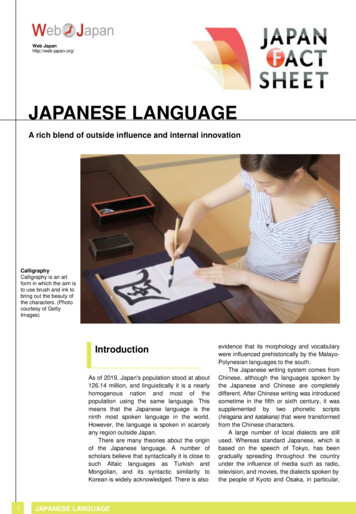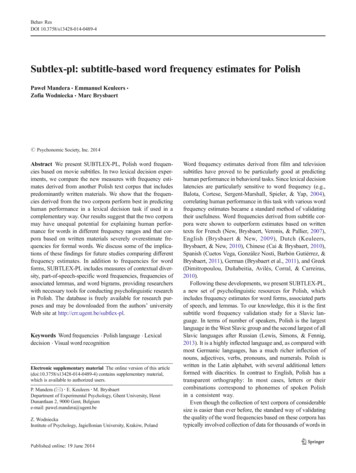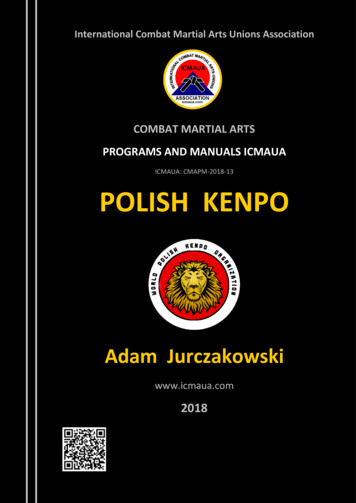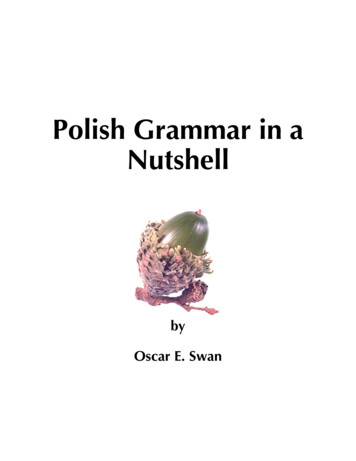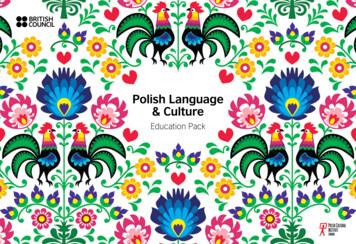
Transcription
Polish Language& CultureEducation Pack
IntroductionLanguages are the bedrock of the world’s cultural heritage.Every language offers a rich and unique insight into differentways of thinking and living as well as into the history of themyriad of cultures and peoples across the globe.British Council: Languages for the FutureDid you know that Polish is now the most commonly spokennon-native language in England and Wales? According tocensus data released by the Office for National Statisticsmore than half a million people now speak Polish as theirfirst language.This education pack is designed to help mainstream primaryteachers introduce aspects of Polish language and culture totheir pupils aged 7–11. It contains lesson and assembly plans,factual information and resources to help pupils develop a deeperknowledge and understanding of the rich language, geography andculture of Poland.The materials are designed to be flexible and adaptable for use in avariety of settings. They can be used as starting points for individuallessons and assemblies or form part of larger cross-curricular jointprojects involving collaboration over a number of subjects. Yourpupils can learn how to greet a friend in Polish, get creative makingpaper cut-outs, and find out about many aspects of Polish culture byusing our wide range of classroom resources and activities.2Polish Language & Culture Education Pack www.britishcouncil.org/schoolsonline
inviaWik imedia CommonsLesson Plan:An introduction to Polish Language11Lesson Plan:Illustrated maps of Poland and the UK13ub5, p Ro by n Mackenzie/ShutterstLesson Plan:Polish Literature 16Wodziń ska , 183Assembly Plan:Let’s Find Out About Poland 4Mar iaIntroduction 2licdomaContentsocm ayd o sPolish Language & Culture Education Pack www.britishcouncil.org/schoolsonlineom / g3ck .cFind Out More 26S toLesson Plan:Children’s Day celebrations 25 iLesson Plan:Polish cooking 24k;Lesson Plan:Polish Folk Art 20
Assembly Plan:Let’s Find Out About PolandThe following notes include background information anda script that you can use or adapt for an assembly. Aslideshow is also available to download sroomresources/list/polish-packPlay some traditional Polish music or a piece by the Polishcomposer Fryderyk Chopin for your pupils to listen to as theycome into and out of assembly. Examples can be found here:www.youtube.com/watch?v uELhJmYq2i0andwww.youtube.com/watch?v BPQn6DLc8B8If you have pupils whose families are from Poland, you couldinvite them to help you to present the assembly and perhapsprepare some short phrases in Polish to demonstrate andtranslate.4Assembly script suggestions:Begin the assembly with the Polish greeting for good morning orgood afternoon – Dzień dobry (pronounced jane DOH-brih) andexplain that in today’s assembly we are going to find out moreabout the European country of Poland and some of the famouspeople who were born there, whose influence can still be seen inthe world today.Assembly slides:1Map of Europe2Map of Poland and surrounding countries3Illustrated Map4Polish Pioneers5Maria Skłodowska-Curie (Marie Curie)6InventionsPolish Language & Culture Education Pack www.britishcouncil.org/schoolsonline
Slides 1 and 2: Maps of EuropePoland is a large country in central Europe with a proud culturalheritage. It is surrounded by seven nations. They are Belarus,Ukraine, Lithuania and the Russian province of Kaliningrad Oblastto the east and northeast, the Czech Republic and Slovakia to thesouth and Germany to the west. To the north is the Baltic Sea.UK5PolandPolish Language & Culture Education Pack www.britishcouncil.org/schoolsonlineWorld with Countries - Outline by FreeVectorMaps.comBackground information for teachers:Poland has had a very eventful history dueto its position in Europe where religions andthe influence of many countries have metover the centuries. It was established byMieszko I over one thousand years ago. Inthe sixteenth century, the country introduceda democratic system, when Noblemen wereable to participate in governing the countryand elect kings and in 1791 it adopted theworld’s second-oldest constitution called theConstitution of May 3. In the twentieth century,the Second World War began with the invasionof Poland by German and Soviet soldiers andafter the war a communist regime was imposedby the Soviet Union. In 1989 Poland regainedfreedom and became a democratic countryand in 2004 – a member of the EU.
Poland statisticsPopulation: 38 millionCapital city: Warszawa (Warsaw)Warsaw population: 1.7 ssian province ofKaliningrad aKrakówCzech h Language & Culture Education Pack www.britishcouncil.org/schoolsonlineWorld with Countries - Outline by FreeVectorMaps.com
Slide 3: Illustrated MapPoland has had several capital cities in the past,but Warsaw is the current capital. The symbolof Warsaw is a mermaid, and a traditional storytells how two fishermen captured the mermaidfrom the River Vistula, when they heard hersinging one night. They blocked their ears withwax and put her in their friend’s barn for thenight, intending to take her to the king and claima reward. The friend forgot to block his earsand when he heard her singing a beautiful sadsong asking to go home to the river he becameentranced and released her and followed herinto the water never to be seen again!Can you spot the Warsaw mermaid on the map?What else can you see? The map illustrationsshow some of the animals and birds that arenative to the country, as well as the locations offorests and lakes, landmarks and places where anumber of famous people were born.7Polish Language & Culture Education PackMaps by Aleksandra Mizielińska and Daniel Mizieliński, published by Templar Publishing.
PublicdomainviaWik imediaCommonSlide 4: Polish PioneerssDid you know that Poland is a country that has produced manydistinguished individuals throughout history? These includethe musician Frederic Chopin, the writer Joseph Conrad, theastronomer Nicolaus Copernicus and one of the greatestscientists of our time – Maria Skłodowska-Curie, perhaps morefamously known as Marie Curie.WeChaPurlk imedia Commons8doWins(Frederic Chopin)cviamonsCommmoain via Wikimediavia Wikimedia Colic domdomain, pubublic41905, prd ,318s foa,reskBezińesodFryder yk Chopinbliainriao rgkMiko łaj Kopernis)curnipeCos(NicolaumMaGeskiJózef Konrad Kor zeniow(Joseph Conrad)Polish Language & Culture Education Pack www.britishcouncil.org/schoolsonlineMaria Skłodowska -Curie(Marie Curie)
PublicdomainviaWiSlide 5: Maria Skłodowska-Curie (Marie Curie)k imedia CommonsMaria Skłodowska-Curie was born in Warsaw in Polandin 1867. She was the youngest of five children and herdiscoveries went on to change the world of science andmedicine. She left Poland when she was 24 to studyin Paris at the Sorbonne, which was one of the fewuniversities in Europe at the time that allowed womento study.She married a Frenchman called Pierre and together theydiscovered two elements polonium and radium. In 1903 she wasthe first woman to receive the Nobel Prize for Physics and is theonly scientist ever to have been awarded two Nobel Prizes indifferent sciences, as she received her second Nobel Prize forChemistry in 1911. Images Doc/ Bay9ard jeunes se. illuPolish Language & Culture Education Pack www.britishcouncil.org/schoolsonlinestration: BenjaminStrickler.FreeImages.com/Mateusz KapciakShe was also one of the first women to obtain a driving licenseduring the First World War, when she developed small, mobileX-ray units that she drove to diagnose injuries near the battlefront.She worked with her seventeen year old daughter Irene, x-rayingwounded soldiers to find fractures, bullets and shrapnel. Her workon the discovery of Radium and other key elements continues tohelp people every day especially if they need an x-ray in hospital.
Image from Wikimedia ComSlide 6: Inventionsmons . AttributioA number of other commonly used inventions created by Polishcitizens include the bulletproof vest, mine detectors, kerosenelamps and paperclips. Perhaps you can find out more about someof these inventions and their Polish inventors after the assembly.And finally – did you know that many of the world’s strongest manwinners also come from Poland?(CC BY-SA3.0)et toPolish Language & Culture Education Pack www.britishcouncil.org/schoolsonline iStock.com/Ljupcovest , inventedby Kazimierz Żegleń iStock .cnportedom /GrassHelenaSunscreen , invented byrenownedldworthe,eininstRubneercosmetic industry pioom /Vadimlike 3.0 U iStock .c10A nn-ShareAdKerosene lamp, inventezwicasieŁukacyby IgnBulletproof
Lesson PlanAn introduction to Polish LanguageIntroductionExplore with your class the nature of verbal and nonverbalgreetings. Why do we use them? How many differentgreetings do we use in English? Ask your pupils todemonstrate how they might greet a friend, an elderlyrelative, their Head teacher and their Head of State. Howmany greetings in other languages do your pupils know?Do they know what they mean in English?Encourage your pupils to try out saying these phrases witha partner. The phonetic pronunciation is given in bracketsor you can listen to the pronunciations at the following linkfrom Fun Kids Radio: -meet-and-greetIn Poland strangers are greeted with a handshake, but when itcomes to friends and family, Polish people usually go for 3 kisses onalternate cheeks.Dzień dobry – Good morningSpeaking other languages is a great skill to have – and as Polishis the second most spoken language in the UK, it’s great to knowsome useful phrases!(jane DOH-brih)(can be used throughoutthe whole day)Do widzenia – Goodbye(doh veed-ZEN-ya)11Polish Language & Culture Education Pack www.britishcouncil.org/schoolsonline iStock.com/Poike piotr pabijan/Shutterstockges, PSHELinks: LanguaCurriculumcollaboration,unication andmomCs:illCore skto greetcitizenship: To learn howesivctjebohLearning1 – 10 in Polisto count fromhlisPoofsomeone andescopiYou will needternet.Resources:cess to the Inac,rsbemnudangreetings
ted a newand the Polish Cultural Institute creaChildren’s radio station Fun Kidshesteachwhicessh! “Learn Polish” is a serikids’ guide to help you learn Polictions,dires,tingand phrases including greeyou some of the most used wordsom/ve.cidslifunkloads more! http://w ww.music chat, animals, cooking andSome other useful phrases:Cześć! – Hi / Bye (tschetsch) You would not say this to strangersJak się masz? – How are you? (yack chye mash?)Dobrze, dziękuję – Good, thank you. (dobje, jenkuye)Jak masz na imię? – What is your name? (yak mash na imye?)Mam na imię Eva. – My name is Eva. (mam na imye Eva)Jesteś Polką? – Are you Polish? (yestesh Polkom?)Ile masz lat? – How old are you? (Il-eh mash lat?)Mam 7 (siedem) lat – I am 7 years old. (mam shyedum lat)Tak – yes (tack)Nie – no (nye)Cześć!12s Radio seriesYou could also try counting from zero to ten in Polish using thefollowing information and watch the animation from Funkids to helpwith the sh/learn-polish-numbersZero – 0Jeden –1Dwa – 2Trzy – 3Cztery – 4Pięć – 5Sześć – 6Siedem – 7Osiem – 8Dziewięć – 9Dziesięć – 10When they have grasped this, you could divide the class into teamsof ten and write the Polish numbers on cards. Shuffle up the numbersand give one to every child in the team. Time how long it takes forthem to sort themselves into numerical order. Can the next group goeven faster?Polish Language & Culture Education Pack www.britishcouncil.org/schoolsonline iStock.com/3sbworld piotr pabijan/ShutterstockPolish Language with Fun Kid“Learn Polish!”
You could organise this as a competition with each group trying tocomplete their list within a set time.Afterwards, ask each group to make a note of any places on the mapsthat they have visited and any illustrations on the maps that theyparticularly like.Lesson PlanIllustrated MapsWhat features are the same and different about the geography of thetwo countries?Poland has a rich heritage of illustration and creative graphicdesign. Print some copies of the illustrated maps of the UK andPoland by Polish illustrators Daniel Mizieliński and AleksandraMizielińska on activity sheets 1 and 2. Divide the class intosmall groups and give each group copies of these illustratedmaps. What are their first impressions? Have they seen mapslike these before? Does anything really stand out or puzzlethem about the illustrations?Encourage your students to look really closely and make a list of allthe physical and human features they can spot on the maps of bothcountries that could be listed under the following categories: 13Names of rivers and citiesLandscape featuresNative animals and birdsArchitectural featuresFamous people thatare mentionedglish, History,Geography, Ens:nkLimluCurricuAr t and designation, Digitality and imaginivatreCs:illn.Core skd collaboratiomunication annaltiocaloliteracy, Comnd: To ex teesivctjeboand identif yLearningpean countr yroEuaofeknowledged maps ofes on illustraturatfealicphgeograe UK.edof the illustratPoland and thill need copieswu,Yolss:iaceeratResour, paper, ar t mK and Polandials.eratmmaps of the Uencrnet or refereteInethtoaccessEncourage them to share their thoughts with the whole group andthen ask each member of the class to choose three of the illustrationsand make their own versions of them in coloured pencils. Which didthey find easiest and most challenging?In the next session, ask each member of the group to select one ofthe categories listed above and carry out some further research. Sofor instance, one member of the group could find out about a riverand city in Poland wh
pupils can learn how to greet a friend in Polish, get creative making paper cut-outs, and find out about many aspects of Polish culture by using our wide range of classroom resources and activities. Languages are the bedrock of the world’s cultural heritage. Every language offers a
